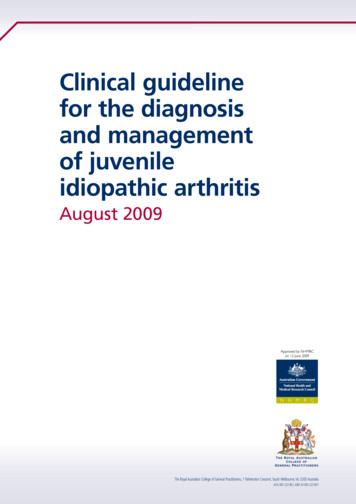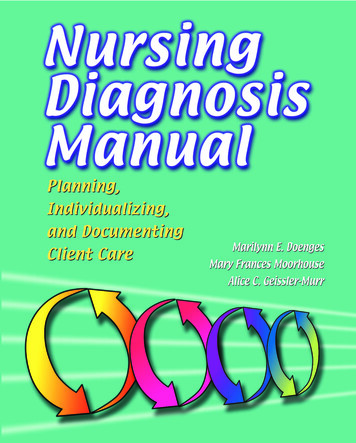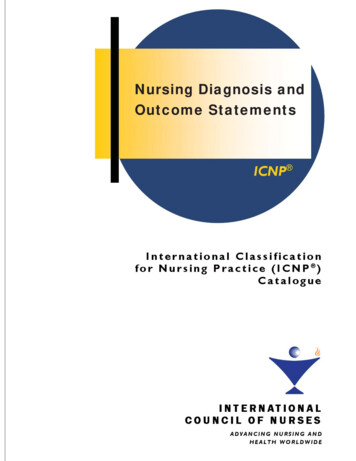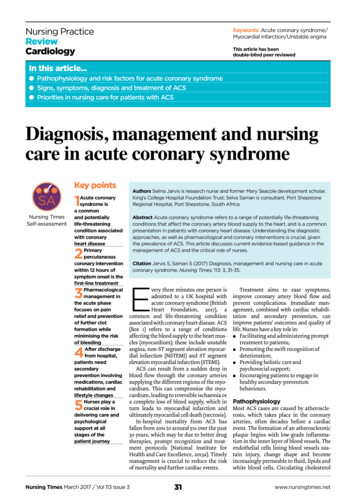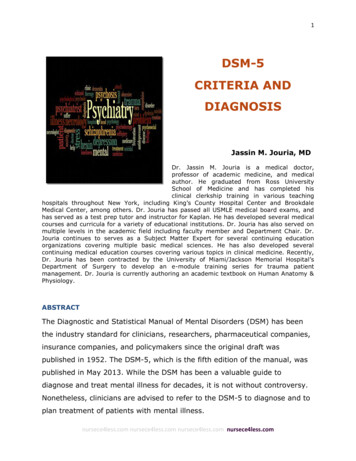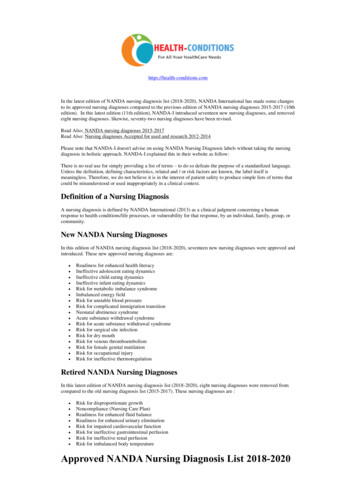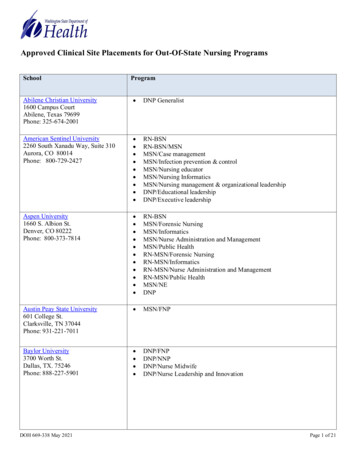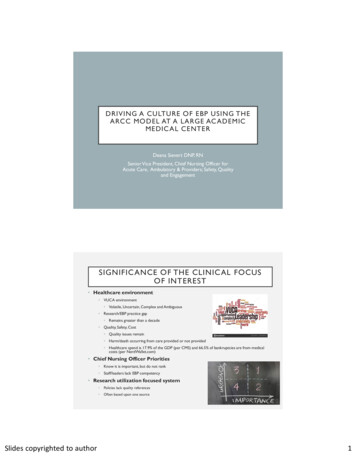
Transcription
Cent Eur J Nurs Midw 2018;9(1):781–790doi: 10.15452/CEJNM.2018.09.0005ORIGINAL PAPERCLINICAL VALIDATION OF NURSING DIAGNOSIS OF ACUTE PAINRadka Kurucová1, Katarína Žiaková1, Elena Gurková2, Mária Hudáková3, Ivan Farský11Department of Nursing, Jessenius Faculty of Medicine in Martin, Comenius University in Bratislava, SlovakiaDepartment of Nursing, Faculty of Health Care, University of Prešov, Slovakia3Department of Anaesthesiology and Intensive Care, Faculty Hospital Prešov, Slovakia2Received May 31, 2017; Accepted November 22, 2017. Copyright: This is an open access article distributed under the terms of the CreativeCommons Attribution International License (CC BY). tAim: To verify, based on clinical validation whether NANDA-I identified defining characteristics of the nursing diagnosisAcute Pain (00132) actually occurred in patients hospitalised in Intensive Care Units in Slovakia and the Czech Republic bymeans of the Clinical Diagnostic Validity Model. Design: Clinical validation of the nursing diagnosis can be verifiedif defining characteristics created on the basis of conceptual analysis and validation by experts are confirmed by clinical data.Methods: We selected Fehring’s Clinical Diagnostic Validity Model as the method of clinical validation. Results: According tothe values attained for Cohen’s kappa coefficient for 18 defining characteristics of the nursing diagnosis Acute Pain (00132)for both Slovakia and the Czech Republic, we can state that the experts agreed relatively fully only on one definingcharacteristic: Changes in Appetite. The attained coefficient value expresses absolute agreement among Slovak experts (1.00)and good agreement among Czech experts (0.86). Conclusion: Analysis and interpretation of the data obtained provides:information on clinically valid defining characteristics of the nursing diagnosis Acute Pain (00132) for Slovakia and the CzechRepublic, information on the agreement between clinical conclusions of nurse-experts from Slovakia and the Czech Republic,and a comparison of the results between Slovakia and the Czech Republic. The study also contributes to the developmentof nursing terminology.Keywords: acute pain, clinical validation, experts, nursing.IntroductionThe process of validation of nursing diagnosesinvolves several methodological approaches, such alisation of diagnoses), and content andclinical validation. Single methodological approachesare used for the creation and modification of nursingdiagnoses, including their cultural adaptation inspecific social-cultural contexts. The validationprocess thus contributes to the support andimprovement of the NANDA Internationalclassification system, in accordance with requests forevidence-based diagnostics (Zeleníková, Žiaková,2010).In the Slovak and Czech social-cultural contexts,validation studies based on Fehringʼs DiagnosticContent Validity Model (DCV) prevail (Fehring,1986). In the last decade, several content validationstudies based on this model have been published inSlovak and Czech contexts. The DCV model hasCorresponding author: Radka Kurucová, Department of Nursing,Jessenius Faculty of Medicine in Martin, Comenius University inBratislava, Malá Hora 5, Martin, Slovakia; e-mail:kurucova@jfmed.uniba.sk 2018 Central European Journal of Nursing and Midwiferybeen used for content validation of the nursingdiagnosis of Hopelessness (Žiaková, Čáp,Holmanová, 2006; Gurková, Žiaková, Čáp, 2011);Acute Pain (Zeleníková, Kozáková, Jarošová, 2014;Zeleníková, Maniaková, 2015); Chronic Confusion(Tomagová, Bóriková, 2011a; Tomagová, Bóriková,2012; Vörösová, Zrubcová, Solgajová, 2013);Impaired Memory (Tomagová, Bóriková, 2011b);Fear (Zeleníková et al., 2012); Acute Confusion(Vörösová et al., 2012); Caregiver Role Strain(Tabaková, Zeleníková, Kolegarová, 2011); DeficientKnowledge (Zeleníková, Plevová, Žiaková, 2012);Deficient Fluid Volume (Zeleníková, Žiaková,Sikorová, 2011), Spiritual Distress (Žiaková et al.,2011); Anxiety (Solgajová, Vörösová, Semanišinová,2012; Bubeníková, Vránová, 2013).Compared to the wide implementation of the DCV,the Clinical Diagnostic Validity Model is applied toa lesser extent in both Slovakia and the CzechRepublic. Clinical validation has been used in fourstudies regarding validation of nursing diagnosisFear (aimed at the paediatric population, Mazalová,Mikšová, Kameníčková, 2013); Caregiver RoleStrain (Kolegarová, Zeleníková, 2011; Zeleníková,781
Kurucová R et al.Kozáková, Jarošová, 2014); and Impaired Comfort(Slamková et al., 2015). In our work, we focusedon clinical validation of the nursing diagnosis AcutePain in Slovak and Czech cultural contexts for thefollowing reasons: the frequency of its usagein clinical practice and in previous studies of contentvalidation. The nursing diagnosis of Acute Pain canbe considered one of the best established nursingdiagnoses, especially for the post-operative period(Junttila, Hupli, Salanterä, 2010; Herdman,Kamitsuru, 2014). Therefore, in our study, weperformed clinical validation of this diagnosis in theconditions of intensive care nursing. None of theknown Slovak and Czech clinical validation studiesfocus on the intensive care environment. Contentvalidation of Acute Pain has been published in twoworks (Zeleníková, Kozáková, Jarošová, 2014;Zeleníková, Maniaková, 2015). Regarding the aspectof continuity of validation methods, we focusedon using the same method of clinical validationin both countries.According to Carlson-Catalano and Lunney (1995),clinical validation can be defined as establishingwhether defining characteristics of a researchednursing diagnosis actually occur in a clinicalsituation. In contrast with studies using contentvalidity, clinical validation research studies verifyvalidity of single diagnostic elements in real clinicalsituations. Clinical validation studies also contributeto the development and testing of a unified nursingterminology. By increasing its representativeness andcapability of generalisation for various patient groupsin different environments, they simultaneously íčková, 2013). Clinical validation has onlybeen performed in 12 validation studies (Kelly, 1991;Carlson-Catalano et al., 1998; Corrȇa, da Cruz, 2000;Young et al., 2002; Giménez, Serano, Marín, 2003;Chaves et al., 2010; Martins, Aliti, Rabelo, 2010;Martins et al., 2011; Rodrigues et al., 2011;Kolegárová, Zeleníková, 2011; Paganin, Rabelo,2012; Mazalová, Mikšová, Kameníčková, 2013;Zeleníková, Kozáková, Jarošová, 2014; Slamková etal., 2015), of which only one concerned the diagnosisof Pain (Corrȇa, da Cruz, 2000). The objective of thestudy was to characterise pain among adult patientsafter cardiac surgery (quality, location and intensityof pain) and to verify defining characteristicsof patients with pain. The study used methodologicalprocedures by three authors (Gordon, Sweeney,1979; Fehring, 1987; Carlson-Catalano, Lunney,1995). The patient sample involved 80 patients aftercardiac surgery. They were divided into two groups:Group A and Group B. Group A patients experiencedpain within the 24 hours before validation or at the 2018 Central European Journal of Nursing and MidwiferyCent Eur J Nurs Midw 2018;9(1):781–790time of validation. Group B patients did notexperience pain within the 24 hours precedingvalidation. Group A was further divided into twosubgroups, validated by objective and subjectivedata: A1 – objective data validated at the onsetof pain and subjective data within the following 24hours; and A2 – both objective and subjective datawere validated for patients up to 24 hours after painmanifestation. Patients validated presence/absenceof single defining characteristics through eithera verbal statement, or by an objective measurementof behaviour. Three tools were used formeasurement: the McGill Pain Questionnaire (MPQ),the Spielberger Anxiety State/Trait Inventory, and theBeck Depression Scale (BDI) (Corrȇa, da Cruz,2000). Overall, 19 defining characteristics wereidentified in this study, 16 of which are describedin NANDA-I Taxonomy II, although definitions didnot match completely. Two characteristics related tochronic pain. Agreement between NANDA-I and thestudy was found in the following four definingcharacteristics: the wording of pain, disturbed sleep,protective gestures and facial expression (Corrȇa, daCruz, 2000).AimThe main objective of our research study was toverify, according to clinical validation, whetheridentified defining characteristics of the nursingdiagnosis of Acute Pain (00132) (from the NANDA-Iclassification system) could be observed in patientshospitalised in intensive care units in both Slovakiaand the Czech Republic, by means of CDV modelimplementation.MethodsDesignThe design of this study is a clinical validation of thenursing diagnosis of Acute Pain. Clinical validationof nursing diagnoses can be verified if definingcharacteristics created on the basis of conceptualanalysis and validation by experts are confirmed byclinical data. Are defining characteristics actuallypresent when a diagnosis is documented in clinicalpractice? For this phase of validation, it is typical touse direct interaction or observation of patientbehaviour by at least two nursing experts. Eachexpert obtains data and formulates conclusionsindependently. Two types of data are monitored:agreement percentage (presence or absenceof definingcharacteristics),andfrequencyof characteristic occurrence in the sample of patients(Hoskins, 1989; Whitley, 1999; Creason, 2004).782
Kurucová R et al.SampleThe sample of the research study involved nursingexperts and selected patients. To determinethe number of clinical experts and patients weapplied Fehring’s recommendations (1987).Sample of expertsThe sample included two nurses from Slovakia andtwo nurses from the Czech Republic. The expertswere chosen by modified criteria proposed forconditions in Slovakia and the Czech Republic byZeleníková et al. (2010). The main criteria forinclusion were: education in nursing and clinicalpractice, with at least one year’s practice in an arearelevant to the NANDA nursing diagnosis of rtification in a clinical practice fieldrelevant to the area of diagnosis, a diploma/rigorousthesis or dissertation in the area of nursingdiagnostics, and a published article in the fieldof nursing diagnostics in a journal (of a research ortheoretical content). According to Zeleníková et al.(2010), a nurse can be considered an expert if theyfulfil four of the criteria.Sample of patientsThe sample included 50 patients from the UniversityHospital, Martin, and 50 patients from the UniversityHospital, Brno. The average age of reviewed patientsfrom Slovakia was 59.92 11.84. The youngestreviewed patient was 31, and the oldest was 83-yearsold. The average age of reviewed patients in theCzech Republic was 65.02 13.81. The youngestreviewed patient was 23, and the oldest was 92-yearsold.The sample of patients included 24 women (48%)and 26 men (52%) from the University Hospital,Martin. The sample of patients from the UniversityHospital, Brno included 18 women (36%) and32 men (64%).The VAS (Visual Analog Scale) evaluation scale wasused to assess pain. The analysis of the results showsthat the mean VAS value in Slovak patients was4.52 1.90. The lowest value in the sampleconsidered was VAS 1, and occurred in two patients,representing 4%. In contrast, the highest value in thesample was VAS 9 and occurred in one patient (2%).The most common occurrence was VAS 5(occurrence in 10 patients, representing 20%) andVAS 6 (occurrence in 10 patients, representing 20%).Analysis of the results shows that the mean VASvalue in Czech patients was 2.82 1.33. The lowestvalue in the sample considered was VAS 0 and VAS1, and occurred in three patients, representing 6%.The highest value in the sample was VAS 6, and 2018 Central European Journal of Nursing and MidwiferyCent Eur J Nurs Midw 2018;9(1):781–790occurred in one patient (2%). The most commonoccurrence was VAS 2 (occurrence in 15 patients,representing 30%), and VAS 3 (occurrencein 14 patients, representing 28%).We also divided the sample of the study according totype of postoperative analgesic management.In Slovakia, the most commonly used type wascontinuous analgesia, which was administered to34 patients. The second most frequently used methodwas administration of analgesia every six to eighthours (11 patients). The least used method wasepidural analgesia (five patients). In the CzechRepublic, the most commonly used analgesic methodwas administration every six to eight hours,(26 patients). The second most frequent method wascontinuous analgesia (14 patients). The least usedmethod was epidural analgesia (10 patients).In Slovakia, classic abdominal surgery was the mostcommon type of surgery, performed on 47 patients(94%). In terms of urgency of surgery, plannedoperations were most common (94%). In the CzechRepublic, classic abdominal surgery was also themost common type of surgery, performed on45 patients (90%). Likewise, in terms of urgencyof surgery, planned operations were most common(74%).The research sample involved patients that metcriteria set in advance: hospitalisation in the IntensiveCare Unit (ICU), nursing diagnosis of acute painmade beforehand, stomach surgery, aged over18 years, absence of a cognitive disorder, and theability to communicate. Exclusion criteria were:impaired consciousness, unwillingness to cooperate.Data collectionAdministration of CDV validation tools wascompleted from July 2015 to January 2016. Forselection of both samples (patients and nursingexperts) criteria were set in advance, i.e., the sampleselection was deliberate. Data were collectedin interviews with patients conducted by nurseexperts in the Department of Surgery andTransplantation Centre of ICU in Martin UniversityHospita
identified defining characteristics of the nursing diagnosis of Acute Pain (00132) (from the NANDA-I classification system) could be observed in patients hospitalised in intensive care units in both Slovakia and the Czech Republic, by means of CDV model implementation. Methods Design
